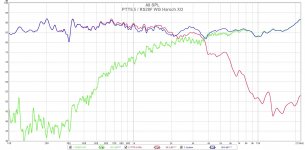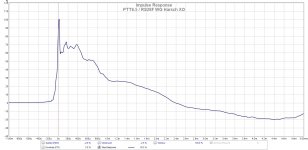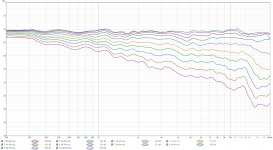Nicely done and thanks for the measurements Erin!
https://www.erinsaudiocorner.com/loudspeakers/march_audio_sointuva/
Looking forward to future designs.
Best,
Anand.
https://www.erinsaudiocorner.com/loudspeakers/march_audio_sointuva/
Looking forward to future designs.
Best,
Anand.
Interesting the shift from the early design with Bliesma T34B to the Satori WG, seems in agreement with Hificompass marriage of the Purifi with a waveguided T25B
I went down a similar path with PTT6.5 and RS28F/RST28F in waveguide and passive radiators. A Be tweeter is cool and all but is it really needed? For those who might be interested in saving several hundred dollars, the RST28F is a very nice sounding option.
That’s sort of on the very top end of my hearing anyhow which falls off rapidly above 18kHz. Instead of a passive radiator, I found a tapered TL to be superior sounding and with more openness on the midrange and great bass articulation and less midrange bleed out through the radiator. This is a great driver combo and lends itself to easy crossover integration. I opted for a high XO point which allowed a quasi transient perfect passive Harsch XO.
Complete CAD plans, XO, STL file for WG adapter etc all here and open source:
https://www.diyaudio.com/community/...using-ptt6-5-and-rs28f-in-a-waveguide.354778/

Step response:
That’s sort of on the very top end of my hearing anyhow which falls off rapidly above 18kHz. Instead of a passive radiator, I found a tapered TL to be superior sounding and with more openness on the midrange and great bass articulation and less midrange bleed out through the radiator. This is a great driver combo and lends itself to easy crossover integration. I opted for a high XO point which allowed a quasi transient perfect passive Harsch XO.
Complete CAD plans, XO, STL file for WG adapter etc all here and open source:
https://www.diyaudio.com/community/...using-ptt6-5-and-rs28f-in-a-waveguide.354778/

Step response:

Looks good, passive XO 1.5K? Was considering T25B with Augerpros' 6.5 WG for next later experiments with PTT6.5.
@julbo That was DSP xo at 2khz, only in a test cabinet. driver CTC was 142mm. Looking at the raw responses I have and with the work I have done on other speakers I have here* , I would expect very near this kind of response would be achievable with passive parts but probably at 2.4khz. Those measurements were actually from when I was experimenting with ways to squash the PTT6.5 port resonances, which also worked out very good. Once my damn back is healed up I will start a final passive build.
But I'm derailing the thread. Erin has been an absolute legend with the NFS (some would argue more so than ....). March audio has done an amazing job with that build. IMO, for passive bookshelf speaker, it doesn't get better. I wish him all the best with sales. I would probably buy a pair if I weren't into DIY. If it were me, I'd put in a tweeter L-Pad old school monkey coffin style so end user could tweak the HF themselves. While I have been working on my PTT6.5 build for as long as March has with the Sointuva, that response is what I hope to achieve with my build, if not better.
*my passive M105 copy on ASR, and a passive MW19TX-4 with a 8" sb26wg. Stupid calibrated mics grumble grumble cant get one here grumble
But I'm derailing the thread. Erin has been an absolute legend with the NFS (some would argue more so than ....). March audio has done an amazing job with that build. IMO, for passive bookshelf speaker, it doesn't get better. I wish him all the best with sales. I would probably buy a pair if I weren't into DIY. If it were me, I'd put in a tweeter L-Pad old school monkey coffin style so end user could tweak the HF themselves. While I have been working on my PTT6.5 build for as long as March has with the Sointuva, that response is what I hope to achieve with my build, if not better.
*my passive M105 copy on ASR, and a passive MW19TX-4 with a 8" sb26wg. Stupid calibrated mics grumble grumble cant get one here grumble
You have no postal/courier services?Stupid calibrated mics grumble grumble cant get one here grumble
havent had usps postal from US to NZ for about 8 months. CS labs wouldnt use anyone else. By the time I figured out a freight forwarder they had sold out.You have no postal/courier services?
https://www.diyaudio.com/community/...uides-for-cnc-3d-printing.318190/post-6970242How do you get the 6.5 WG?
or Sointuva's one? here:
https://www.madisoundspeakerstore.c...bnwg-4-beryllium-dome-tweeter-with-waveguide/
spenny. very spenny.
Thank you for that and thanks for writing that up! Gosh, I wish I could just buy it. Can’t we do a group buy? Many thanks to augerpro and all of you for bringing this to the community. I am not computer illiterate but this is still a lot of work for me.
The way I see it, this could really open up simple two way designs for everyone while also delivering stellar performance.
The way I see it, this could really open up simple two way designs for everyone while also delivering stellar performance.
Blame the toothy one for that. Had no difficulty in Oz beyond some delays vis-a-vis pre hysterical virus times.havent had usps postal from US to NZ for about 8 months.
spenny. very spenny.
The waveguide version of this tweeter is about $100 more than the standard "flat face" version... $500 vs $400. I think that is a reasonable charge for an aluminum waveguide.
Yes, Agreed. I didn't look at the standard be dome. The price we pay for beryllium tweeters. Surprised SB didn't do the same WG on the sb26adc. Not like that little fabric one they did.
I'll have some of the SB WG Be tweets soon. It will be interesting to see how much actually audible difference they make esp as the soft ones are pretty darn good. Plus I have 2 older designs I want to reference them to; one still in production, one not. And I have the TPL150H, some Fountek 5i and a metric ****ton of CDs WGs and horns.spenny. very spenny.
Details at 11.
I see a lot of people design their tweeters around 2dB lower than the midwoofer. This includes the prolific designer Troel Gravesen.
Doesn't this sound dark to you?
There is research which shows that most people prefer an in-room response that gently slopes down by about 1 dB per octave from 100 Hz to 10 kHz. By in-room I mean as measured at the listening position, at a normal listening distance.
That is about 6 dB total drop from 100 to 10k. If the room is well damped, and the listening distance is large enough, then the natural LF room gain and HF loss will create this preferred response at the listening position. However, in many rooms it will not, so the designers engineer a non-flat response into the speakers to try to achieve this. Shelving the tweeter down by a few dB will often get the job done.
I have found it is program dependent also. I have three DSP filter presets which I can switch between. Preset (1) is anechoically flat on-axis, preset (2) has a smooth 4 dB drop from 100 to 10k, and preset (3) has a smooth 6 dB drop from 100 to 10k. I have found that preset (1) is best on most classical music and most jazz, but it is too bright on nearly all pop music. For those I use preset (2). Only a few recordings are so bright that they need preset (3).
j.
That is about 6 dB total drop from 100 to 10k. If the room is well damped, and the listening distance is large enough, then the natural LF room gain and HF loss will create this preferred response at the listening position. However, in many rooms it will not, so the designers engineer a non-flat response into the speakers to try to achieve this. Shelving the tweeter down by a few dB will often get the job done.
I have found it is program dependent also. I have three DSP filter presets which I can switch between. Preset (1) is anechoically flat on-axis, preset (2) has a smooth 4 dB drop from 100 to 10k, and preset (3) has a smooth 6 dB drop from 100 to 10k. I have found that preset (1) is best on most classical music and most jazz, but it is too bright on nearly all pop music. For those I use preset (2). Only a few recordings are so bright that they need preset (3).
j.
- Home
- Loudspeakers
- Multi-Way
- March Audio Sointuva
